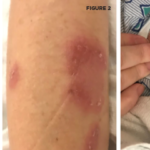What about scarring after genital ulcers heal? Does that increase the chances of BD? “It does, but many types of genital lesions heal with scars, and that isn’t limited to BD,” noted Dr. Nowatzky. “In the U.S., many diseases, like hidradenitis suppurativa, vulvar Crohn’s and various forms of genital lichen can give you genital lesions that scar.”
Skin Lesions
Skin lesions are common in BD, too, but also have low specificity. These may include nodular lesions caused by erythema nodosum or superficial thrombophlebitis, papulopustular and pustular acneiform lesions. When it comes to the latter, location is key. Dr. Nowatzky pointed out that pustular lesions often occur on the arms and legs in BD, as opposed to the face, as with pubertal acne vulgaris.
Of note, skin pathergy has high specificity for BD, but is not pathognomonic.
Major Organ Involvement
“Almost everything can be involved in BD, but the kidneys typically aren’t,” Dr. Nowatzky offered. He touched on central nervous system, GI tract, vascular and ocular manifestations of disease.
Neurologic BD comes in two flavors: dural venous sinus thrombosis or parenchymal (axial) neuro-BD. The latter usually involves the brain stem and adjacent regions, usually with cerebrospinal fluid (CSF) pleocytosis and elevated CSF protein. “Parenchymal neuro-BD patients usually get recurrent disease and have a bad prognosis, but we can treat with tumor necrosis factor inhibitors these days,” he said.
As for the GI tract, Dr. Nowatzky noted that “it can be involved, but much less frequently than commonly assumed, especially in patients not of East Asian ancestry.” When BD does affect the GI tract, it causes deep, often solitary, ulcers that, unfortunately, have a predilection for the terminal ileum, as in Crohn’s disease, for example. Unlike Crohn’s disease, patients with BD have little to no colitis outside the immediate vicinity of the ulcers and a higher risk of bowel perforation.
When it comes to blood vessels, pulmonary artery aneurysms are nearly pathognomonic for BD, and hemoptysis is a very concerning sign of this. Other warning signs to be on the lookout for include unremitting headache (concerning for dural venous sinus thrombosis) and new-onset ascites (concerning for Budd-Chiari syndrome), or signs of deep vein thrombosis. “Fever, evidence of collateral vessel formation, pulsating tumors and superficial thrombophlebitis should also raise concern for vascular disease,” added Dr. Nowatzky.
As for the eyes, inflammation in BD is intra-ocular (i.e., uveitis). It’s important to remember that there’s always a differential diagnosis for eye disease, and location of inflammation helps narrow potential causes.2

